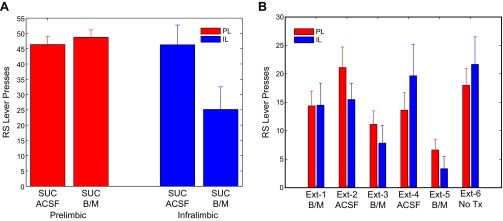Fig. S5.

Pharmacological inactivation of PL (red) or IL (blue) using bac/mus (B/M) during DS-sucrose (A) or alternating days of extinction (B). ACSF was given on control days. Inactivation of IL, and not PL, decreased responding during DS-sucrose [PL, t(7) = 0.70; P > 0.05; IL, t(6) = 3.46; P < 0.05, paired t test]. During extinction, inactivation of PL and IL decreased lever presses, which rebounded on ACSF days [PL, χ2(4,28) = 9.53; P < 0.05; IL, χ2(4,20) = 14.67; P < 0.01, Friedman test]. Over the entire extinction session, inactivation of PL and IL neurons impaired extinction learning such that there were no significant differences between extinction day 1 and extinction day 6 (PL, signed-rank = 12.5; P > 0.05; IL, signed-rank = 7; P > 0.05, Wilcoxon test). These data indicate a broad influence of PL and IL manipulation on task performance not selectively limited to response execution or inhibition per se. Further discussion is provided in the main text.
